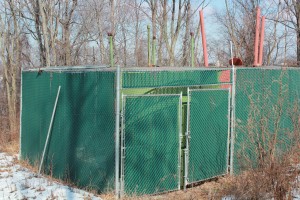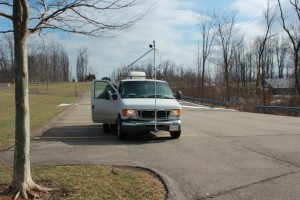Measuring the climate trade-off between coal and natural gas
-
Susan Phillips
President Obama’s plan to combat climate change relies heavily on replacing coal with natural gas as a way to reduce the amount of carbon dioxide electric power plants pour into the atmosphere. But natural gas comes with it’s own climate problems.
Methane, the main component of natural gas, is also a powerful greenhouse gas, which can be 84 times more potent than carbon dioxide within twenty years. And with so many opportunities for unburnt methane to escape on its way from the wellhead to the power plant, those leaks could offset any benefits from burning natural gas instead of coal. Scientists have just begun to try to measure those leaks. One team of researchers from Carnegie Mellon University in Pittsburgh, spends their days chasing methane plumes.
Soccer fields, dog walkers and gas wells
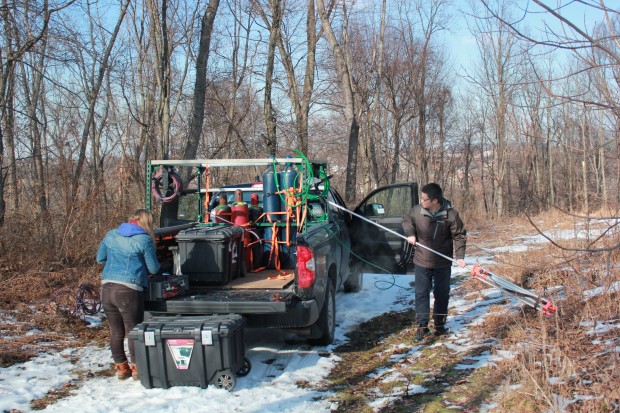
Susan Phillips / StateImpact Pennsylvania
Researchers Xiang Lee and Melissa Sullivan prepare to measure methane from a well site in Monroeville Community Park.
A town park may seem a surprising place to find natural gas wells. But this is southwestern Pennsylvania, the heart of the state’s drilling boom. Today, the researchers are in a pristine park in the Pittsburgh suburb of Monroeville. Recent snowfall still crunches underfoot. And tucked away behind green fences that would typically hide Dumpsters are natural gas wells.
After a park worker opens a gate for the research crew, their truck makes a quick left down Gazebo Lane, crosses Soccer Street, and we wind our way past baseball diamonds, tennis courts, and dog walkers.
They quickly get to work unloading equipment used to track the well site’s emissions. Researcher Mark Omara explains how its done. Containers of nitrous oxide and acetylene sit in the back of their truck. These are used as “tracers,” harmless chemicals that they release near the well site to help them trace whether methane is leaking. Omara and his colleagues Xiang Lee and Melissa Sullivan unwind lengths of green hoses that attach to the chemicals in the truck. They run the tubing to tripods, which stretch about 7 feet high.
“So that green tubing used to convey nitrous oxide from the truck to this tripod here, that needs to be placed near the emission source,” says Omara.
The emission that researchers like Mark Omara are interested in is methane. They are trying to check as many natural gas wells and production sites as possible to find out how much of this colorless, odorless gas is leaking. In this case, the well is not tapping the Marcellus Shale, but a more shallow formation and is considered a “conventional well.” Altogether, Pennsylvania has 132,829 active conventional and unconventional gas and oil wells.
New focus on methane emissions
The Environmental Protection Agency doesn’t regulate methane as a pollutant. But the agency recently proposed regulations aimed at cutting methane leaks from new well sites. The EPA’s plan will target new and modified sources of methane leaks within the production process and along the supply chain. The goal is to cut methane leaks by 40 to 45 percent by 2025, using 2012 as the baseline. But in order to reach that goal, more information is needed to figure out how much is leaking, and from where.

Susan Phillips / StateImpact Pennsylvania
Carnegie Mellon University professor Albert Presto at his office in Pittsburgh.
Albert Presto is a professor at Carnegie Mellon University and the lead investigator on this study. Presto’s career has up until this point focused on air pollutants from car exhaust and coal. In his campus office he talks about how methane is not an immediate threat to those breathing it. It doesn’t cause asthma or lung cancer. The most immediate threats from methane come from explosions if it builds up in enclosed environments. But it does contribute to global warming. And almost 10,000 new shale gas wells have been added in Pennsylvania alone, in the past ten years.
Presto’s new research is funded by the Department of Energy.
“This is really a function of the shale gas boom,” said Presto. “One of the questions is how much is this new methane source changing the total methane picture?”
Presto doesn’t want to say until he’s crunched all the numbers.
But here’s why that data on methane is so important to how we heat our homes, refrigerate our food, and not have to read by candlelight.
Coal generates about half of Pennsylvania’s electricity. But tons of data stretching back decades, shows how coal pollutes the air we breathe and it sends carbon dioxide into the atmosphere, causing global warming. When power plants switch to burning natural gas, CO2 emissions drop.
That’s why President Obama’s plan to combat global warming relies so heavily on the switch from coal to natural gas.
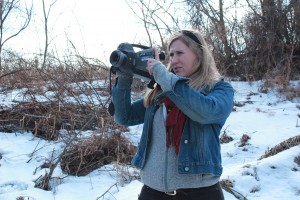
Susan Phillips / StateImpact Pennsylvania
Melissa Sullivan uses an infrared FLIR camera to determine if methane is leaking from a well site.
But methane is a greenhouse gas too. And it can warm the Earth a lot faster than CO2, speeding up the impacts of climate change.
Mark Brownstein is associate vice president at the Environmental Defense Fund.
“So even small leaks across the natural gas supply chain can undo some or all of the climate benefits you think you’re getting when you’re substituting natural gas for coal,” said Brownstein.
Scientists have just begun to take a look at this tradeoff. A recent study by the University of Texas pointed to a wide disparity in natural gas production sites, with most leaking relatively little, while others pouring out large amounts of the greenhouse gas. Their research concluded that pneumatic devices and liquid unloadings pose the most risk to fugitive methane. And just a small percentage of each device tested account for the bulk of emissions. Pneumatic devices use natural gas to control valves. Liquid unloadings refers to a process, usually in older wells, where accumulated liquids have to be cleared in order to continue producing gas. That report was funded by the Environmental Defense Fund, along with ten oil and gas producers.
Many environmentalists say that aside from the emissions question, relying on any new fossil fuel to solve the climate problem blocks the development of renewables. Presto says he’s a pragmatist when it comes to the shale gas boom and says it’s not going away. But he gets the argument against fossil fuels.
“Sometimes its hard to shift,” says Presto. “If we wean ourselves off making electricity from coal and start making a lot from gas are we really just kicking the can down the road? And in 30 to 60 years are we going to have the same debates, well, what would be the next fuel? And its not clear to me how swapping out coal powered electricity for natural gas powered plants enables more renewables or carbon capture.”
Chasing the plume
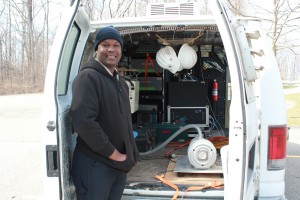
Susan Phillips / StateImpact Pennsylvania
Mark Omara stands in front of a van outfitted with sensors to record methane emissions in real time.
Once the researchers release their tracers near the well site, it’s time to start chasing the plume. Using a van outfitted with a sensor at the top, Omara and Lee take off along residential roads downwind, trying to find their tracers, which would be flowing along with any methane coming from the well site. The tripods that hold up the tubing, also have weather stations that give wind speed and direction.
The well site is tucked away at a little used corner of the park and behind the fencing are several large tanks. These tanks collect condensates, or natural gas liquids like butane and propane. The tanks serve to separate the condensates from the “dry” gas. Unloading that gas from the tanks can result in large releases of methane.
“And that’s what we’re trying to understand,” said Omara. “How much comes out during this process? [Our research] encompasses a large cross section of the natural gas sector so we’re not just doing sites in normal production.”
Omara says they’re testing active drill sites, active production sites, wells that are flaring and compressor stations.
While Omara and Lee chase the plume, researcher Melissa Sullivan takes out an infrared camera, called a FLIR, and gets as close to the well as possible. She’s trying to see whether methane, invisible to the naked eye, is coming off of the site. Sullivan says often, she can hear a large leak hiss. But today, not much is showing up on her camera.
Omara and Lee return to find the plume has not moved so far from the well. The day is clear, and not very windy. Inside their van, which is humming with electricity, are tools to measure the methane and computer screens that show all kinds of graphs with little black and red dots popping up in real time. Omara explains the results.
“The methane are these black dots here,” said Omara. “So the rise above background is actually very small. Which is what we would expect for a site that’s well maintained. This is less than 10 ppb rise above background, that’s parts per billion. Imagine if you’ve got a sack of a billion beans and you’re only getting ten out of that so it’s really really small.”
When Omara talks about the background level, he means there are other sources of methane. Methane can come right from the soil as part of its natural decay, but another large source is livestock. In order to get an accurate measure of methane from natural gas production sites, the researchers have to account for the methane that’s already there.
But these researchers are also seeing the variation of results from well to well that the Texas study found.
“Oh yes absolutely, we’ve seen wild things,” said Omara, “where you see methane that is almost 60 PPM (parts per million) above background. So it’s unbelievable when you see something like that. But this is a clean site. I can tell you that just by looking at it.”
Death by ten thousand wells?
Back in his office at Carnegie Mellon, Omara’s boss Albert Presto, tells me most gas wells leak less than one percent of their total production.
“So the thing to think about is it’s less than one percent over huge volumes of natural gas, or many numbers of wells. And so even if the absolute number is small, it’s over a large number of facilities. In aggregate you can have a lot of emissions.”
So even if all those wells are leaking just a little bit of gas, remember the last ten years has added almost 10,000 new shale gas wells. And some Marcellus Shale wells are breaking records for production. Added all up Presto says a lot of methane could be flowing into the atmosphere.
“I think if the [emissions] are less than 2.5 to 3 percent of total production then we’re safe in this switch away from coal,” said Presto. “And if emissions are above 6 percent of production, we’re sort of in this climate disaster territory. What we’ve seen is that we’re below that. But we’ve got to quantify the high emitter, most of the emissions come out of those. So nailing that down really is the big challenge.”
So the key question is, how many of those high emitting wells, the kind that researcher Mark Omara called “wild,” just how many are there? And are they leaking enough to offset the cleaner wells like those in Monroeville Community Park?
That’s just one question scientists and environmentalists want answered before President Obama puts so many of his climate eggs in the natural gas basket.

